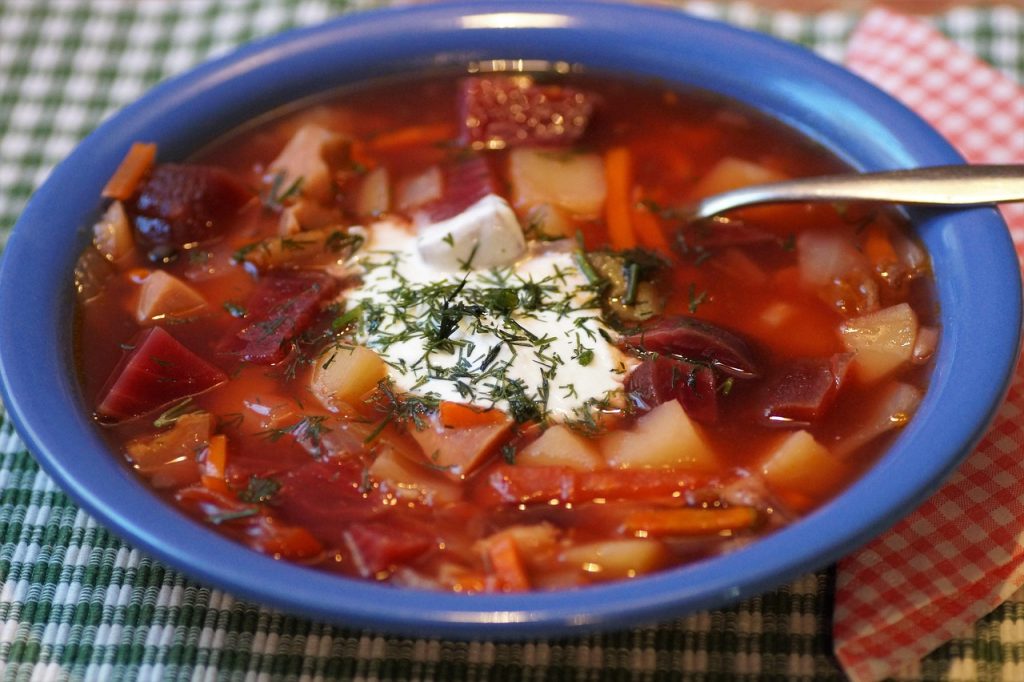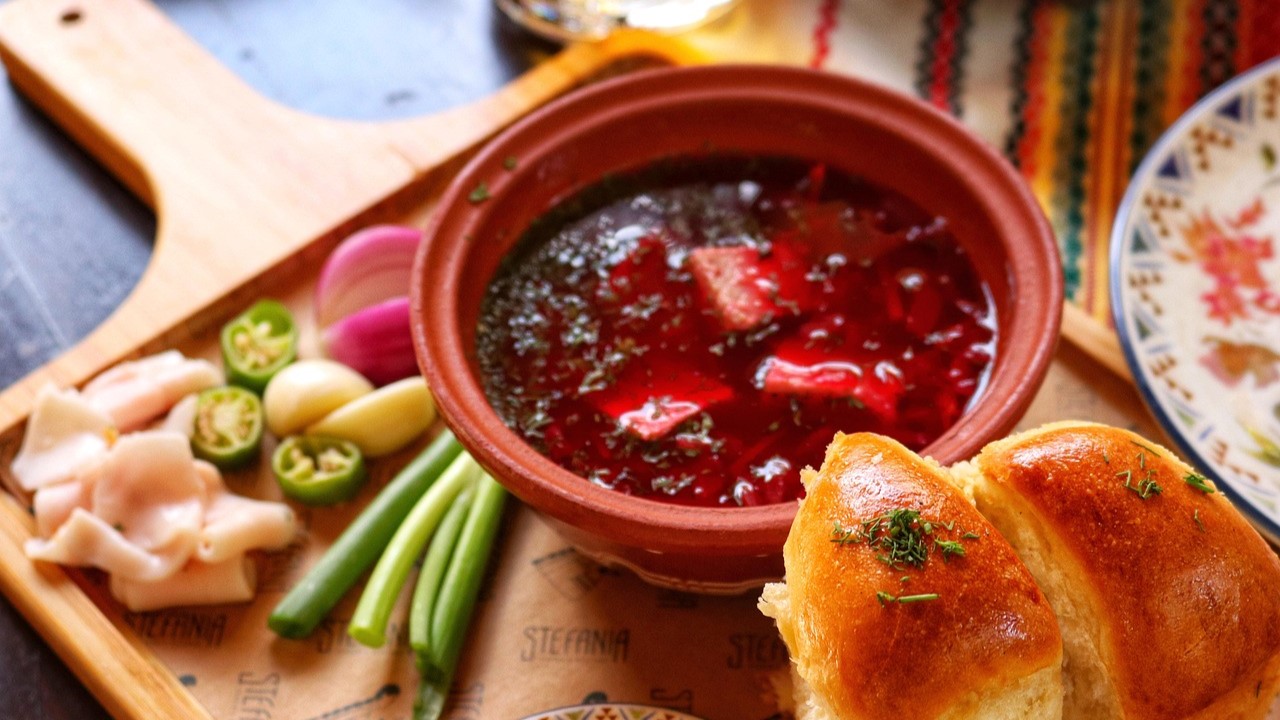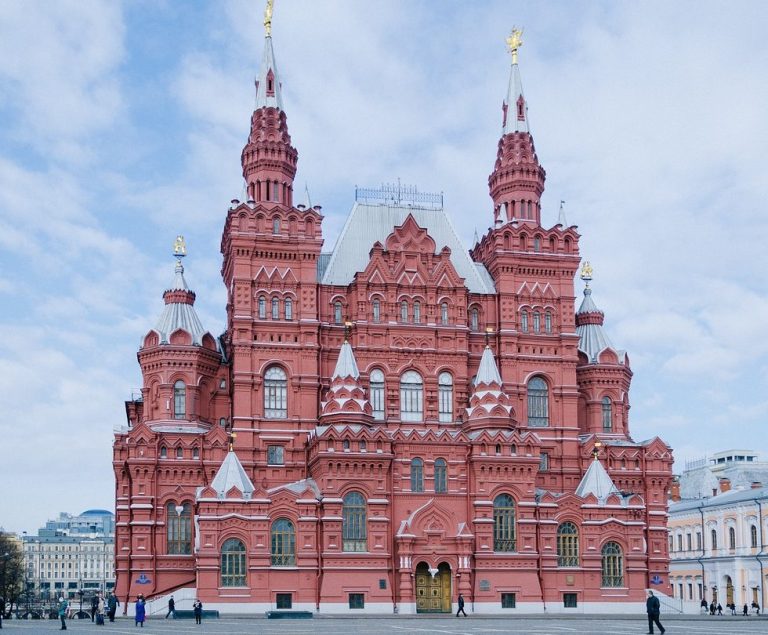Ask ten people about Russia’s national dish, and the debate begins quickly. Borscht is a word that keeps popping up. In English, it often refers to the beet soup associated with Ukraine. Yet, in Russian kitchens, the term encompasses more.
Borscht can be hot or cold, with a vibrant red color or a pale, tangy hue. It can be rich with meat or light as a broth. This versatility highlights Russia’s culinary heritage, spanning vast distances and enduring long winters.
The story of borscht is one of migration and adaptation. It traveled with migrants from the Russian Empire to Canada and the United States. There, it became a staple on Ashkenazi and Mennonite tables, from Brooklyn to Manitoba.
In Russia, cooks create their own versions of borscht. There’s Siberian meatball borscht, Pskov versions with dried smelt, and Lenten pots with kelp for fast days. These variations reflect the influence of climate, faith, and trade on local tastes.
Today, borscht remains a central figure in Russian culinary culture. It represents both home cooking and café culture. Whether served hot with smetana and dill or chilled with crisp cucumbers, borscht is more than a recipe. It’s a symbol of comfort, adaptability, and Russian culinary heritage.
Russia’s Traditional Gastronomy: Context for an Iconic National Dish
In vast forests and long winters, Russian cooking grew around warmth, thrift, and comfort. Hearty soups, slow baking, and smart pantry use shaped the cuisine. This created a style that’s rustic yet careful, simple yet full of character.
Russian Culinary Heritage and Dining Culture
The Russian oven was key. Vegetables were cooked ahead, then added to stock for perfect doneness. This method is seen in borscht, with a quick version called “borshchok.”
Meals are communal. Russian dining culture loves shared bowls, rye bread, and smetana. In Moscow’s Varenichnaya No. 1, this keeps dishes hot and social.
Famous Russian Food and Iconic Russian Dishes in Global Context
Some dishes travel far. Borscht and pelmeni from Siberia show tradition meets everyday life. In North America, borscht became known through Jewish and Mennonite kitchens.
- Borders blur: versions appear in Ukraine, Poland, Lithuania, Belarus, and Russia.
- At home, cold borscht pops up in summer; in winter, richer stocks take the lead.
This keeps Russian cuisine visible globally while staying true to its roots.
Seasonality, Climate, and Preservation Shaping Traditional Russian Cuisine
Short summers and long frosts mean planning is key. Cabbage, potatoes, and beets store well. Pantries hold ferments that add flavor on dark days.
Preservation adds a sweet-and-sour edge: beet sour, pickle brine, sauerkraut juice, and fermented rye. In hot months, chilled borscht cools the table. When it’s snowy, deeper broths warm the soul, showing Russian cuisine’s adaptability.
What Defines a National Dish in Russia’s Culinary Identity
The national dish of Russia isn’t set by law. It’s shaped by what families cook often. It’s what travelers find in homes and canteens, from Kaliningrad to Vladivostok. Borscht is a dish that many kitchens share, telling a story across a vast area.
Borscht’s flexibility is key. It can be made with rich beef broth or lighter mushroom or fish broths. Some serve it clear, while others make it thick. It changes with the seasons, from cold in summer to hot in winter. This adaptability keeps borscht a beloved dish, tied to daily life.
The word “borscht” has deep roots. It comes from Proto-Slavic, shared by Russians and Ukrainians. Ukraine’s beet-based borscht is UNESCO recognized. Yet, Russian cooks add their own twist, making it a part of their heritage.
At the table, context is everything. Meatless fasts mean more mushrooms and fish. Family gatherings enjoy hearty stocks and smetana. Street cafés offer affordable, familiar borscht, showing how traditions are passed down.
Borscht is joined by pelmeni and festive dumplings. These dishes are travelers in their own right. They add to the mix of Russian dishes, carried by memory and tradition.
National Dish of Russia: Borscht’s Place in Popular Imagination
Borscht is a mix of memory, migration, and daily life. It’s found in cafés from Moscow to Brooklyn. Its red color signals a dish many see as part of Russia’s culinary identity.
Origins and Spread of Borscht Across Eastern Europe and North Asia
The story of borscht begins with a sour soup from Slavic lands. Over time, it evolved into the beet-based soup we know today. Trade and migration helped it spread across Eastern Europe and North Asia.
By the late 19th and early 20th centuries, borscht reached North America. It became a staple in New York and Montréal delis. This spread made it a famous dish worldwide, shaping Russian dining culture abroad.
Ukrainian Roots, Russian Variants, and Shared Culinary History
Ukraine is at the heart of borscht’s story. UNESCO recognized Ukrainian borscht cooking as a cultural treasure in 2022. This recognition highlights the beet-based style popular globally.
Neighboring kitchens share a culinary history. Russian borscht varies from Siberian to Pskov’s dried smelt version. Each version reflects regional tastes, yet all fit the idea of a national dish of Russia.
Hot and Cold Serving Traditions, Smetana, Dill, and Classic Garnishes
Season affects how borscht is served. In winter, it’s hot, with steam curling over the beet flavor. Summer brings a chilled version, often with kefir or yogurt, and garnished with cucumbers and radishes.
Garnishes like smetana, dill, and halved hard-boiled eggs add to the dish. Pampushky, soft rolls with garlic, invite dipping. Sometimes, beans, bacon, or smoked meats are added, showing the variety in Russian dining culture.

Borscht Essentials: Ingredients, Flavor Profile, and Authentic Russian Recipes
Borscht is a mix of tradition and taste, a beloved dish in Russia. It’s made with slow-cooked stock and beets. This dish is both traditional and flexible, loved by many.
Core Components: Meat or Bone Stock, Beetroots, Cabbage, Potatoes, Tomatoes
A rich stock is the base. Beef, pork, or poultry simmer for two hours. Marrow bones simmer for four to six hours for a silky texture.
Meat is removed mid-simmer and returned 10–15 minutes before serving. This keeps the meat tender.
The vegetables include beetroots, cabbage, and potatoes. Onions, carrots, parsley root, and tomatoes or paste are also used. Extras like beans, apples, turnip, and zucchini add local flavor. This mix is true to traditional Russian cuisine.
Sweet-and-Sour Balance: Beet Sour, Vinegar, Pickle Brine, or Kvass-Like Ferments
The dish is known for its sweet-and-sour taste. Classic cooks use beet sour, a ferment of sliced beets. It adds a deep red, tangy flavor near the end.
Modern cooks use beet juice with vinegar or lemon juice. Dill pickle brine or sauerkraut juice are also used. The goal is a lively, vibrant taste.
Traditional Technique: Precooking Vegetables and Russian Oven Heritage
Technique is key. Onions, carrots, and roots are sautéed first. Then, they meet tomatoes and stock after potatoes and cabbage soften.
Season with salt, black pepper, bay leaf, garlic, and dill. Optional spices include allspice and ginger. The method is rooted in Russian oven traditions but works on modern stovetops.
Garnishes and Sides: Smetana, Eggs, Pampushky, Beans, Sausages
Finish with smetana and fresh dill. Hard-boiled eggs add creaminess. Beans add heft. Return the stock meat for a heartier dish.
Regional tables serve pampushky or halushky on the side. Some pair it with Vienna sausages. This shows how borscht can be a comfort food or a festive centerpiece.
| Element | Traditional Choice | Modern Swap | Flavor Impact | Notes From Authentic Russian Recipes |
|---|---|---|---|---|
| Stock Base | Beef or pork with marrow bones | Chicken or mixed meats | Deep, silky body | Simmer 2–6 hours; add meat back before serving |
| Vegetables | Beetroot, cabbage, potatoes, onions, carrots | Beans, tart apples, bell peppers, celeriac | Earthy-sweet core with lift | Precook aromatics in lard or butter for richness |
| Acidity | Beet sour (kvass-like ferment) | Vinegar, pickle brine, sauerkraut juice, lemon | Bright, tangy finish | Add near the end to keep color and snap |
| Seasoning | Salt, black pepper, bay, garlic, dill | Allspice, marjoram, hot pepper, saffron, prunes | Herbal warmth, gentle heat | Adjust to region and season; keep balance |
| Garnish & Sides | Smetana, dill, pampushky | Hard-boiled eggs, sausages, bacon | Creamy contrast and heft | Makes a popular Russian meal fit for any table |
Borscht is all about balance and care. This simple harmony makes it a beloved dish in Russia. It’s a dish that honors tradition while allowing for personal touches.
Regional Expressions: From Russian Navy Borscht to Siberian and Monastic Lenten Styles
Borscht changes across vast lands, showing Russia’s traditional food ways. Each bowl shares a common theme but shows the local climate, faith, and water. This turns one soup into many, adding new views to classic dishes while keeping the beet-red core.
Siberian Style With Meatballs; Flotsky Cutting Style; Pskov Dried Smelt Version
In Siberia, meatballs called frikadelki cook in the soup. This makes the soup hearty and vibrant, perfect for long winters. It’s a dish made for big appetites and cold weather.
At sea, sailors enjoy flotsky borscht. It’s cut into small squares or diamonds, making it neat for a moving kitchen. The taste is classic, but the texture is more even, showing how sea life shapes food.
In Pskov, dried smelt adds a salty flavor. This fish enhances the beet soup without overpowering it. It’s a tribute to the local markets and the sea’s influence.
Lenten and Vegetarian Approaches: Mushroom or Fish Stock, Kelp Instead of Cabbage
Monastic cooks created meatless dishes that are rich. Mushroom broth adds earthy flavors, while fish stock keeps a coastal taste. Some Lenten recipes use marinated kelp instead of cabbage, adding a fresh, sea-like taste.
These methods fit well within Russia’s traditional food culture. They show how fasting seasons add depth to classic dishes. The soup feels lighter but stays true to its beet-based roots.
Cold Borscht Traditions With Kefir or Yogurt, Cucumbers, Radishes, and Dill
When it’s hot, cold borscht is refreshing. It’s made with kefir, yogurt, or buttermilk mixed with beet juice. Chopped beets, cucumbers, radishes, green onions, and dill are added, topped with halved eggs.
Some recipes include chopped veal, ham, or crawfish tails. This adds a touch of luxury to the cool soup. It’s a summer favorite in traditional Russian cuisine, balancing coolness and richness.
Beyond Soup: Dumplings as Cultural Pride—Pelmeni and Vareniki in Russian Dining Culture
Dumplings are a big part of Russian dining culture. They are loved and enjoyed every day. Along with borscht, they are iconic dishes with deep family ties.
In Moscow and Siberia, people argue over which dumpling is better. This debate shows how climate, thrift, and taste influence Russian food. It also highlights the influence of Ukraine on Russian cuisine.
Pelmeni as Siberia’s Practical Staple: Thin Dough, Raw Minced Meat Fillings
Pelmeni come from Siberia and the Urals. Hunters made them in the cold, freezing them outside. They are small, have thin dough, and are filled with raw minced meat.
They are quick to make and cook, keeping their juices inside. This practicality makes them a favorite in Russia, enjoyed all year.
Vareniki’s Ukrainian Heritage and Sweet-Savory Versatility at Russian Tables
Vareniki are bigger and have thicker dough. They come from Ukraine but are loved in Russia. They can be filled with potatoes, tvorog, sauerkraut, mushrooms, cherries, or poppy seeds.
Making vareniki is a family activity before holidays. This tradition makes them a beloved part of Russian cuisine.
Serving Styles: Sour Cream, Butter, Vinegar, Fried Onions, and Broth
There are classic ways to serve dumplings. Smetana adds creaminess, butter gives gloss, and vinegar brightens the meat. Fried onions add a sweet crunch, and broth turns them into a warm bowl.
- Pelmeni: smetana or vinegar, then butter; sometimes crisped in a pan after boiling.
- Vareniki: fried onions and butter for savory; sugar or a drizzle of honey for cherry versions.
Everyday Convenience vs. Festive Traditions in Popular Russian Meals
Pelmeni are a quick and easy choice for busy nights. They are a staple in Russian homes, needing only boiling water and smetana.
Vareniki, on the other hand, are for special occasions. They are a nod to Slavic heritage, enjoyed at gatherings and weekend meals. Together, they show how Russian cuisine balances everyday needs and festive traditions.
Russia’s Wider Culinary Tapestry: Regional and Ethnic Influences
Across the Urals, Russia’s traditional gastronomy changes with the landscape. Bashkir tables show how local tastes shape famous Russian food. These local habits add depth to traditional Russian cuisine.
Bashkir Cuisine: Beshbarmak, Kumis, and Dairy Pairings Reflecting Steppe Life
Beshbarmak is a staple with boiled horse meat or lamb, wide salma noodles, onions, and herbs. It’s often served with qurut or sour cream. Kumis, a drink from mare’s milk, is fresh and tangy.
These choices reflect Russia’s traditional gastronomy. Mobility and herding shaped cooking and pantry staples. Traditional Russian cuisine meets open-country logic: protein-rich plates balanced by fermented milk and herbal notes.
Long-Storage Foods, Honey Traditions, and Tea Culture With Milk
A semi-nomadic pace favored foods that last. Boiled-and-dried horse meat and lamb, jerky, dried berries, and cereals were staples. Dairy, like qurut, irimsik, and ayran, kept camps supplied when travel was long.
Honey is central. Bashkir honey from Burzyan bees sweetens tea tables. Tea with milk is the default pour, showing Russian culinary heritage while staying true to steppe taste.
How Regional Diversity Enriches Iconic Russian Dishes
Regional habits quietly influence famous Russian food. Borscht can have richer dairy sides or a sharper, fermented edge. Dumplings carry wedding customs like keyeu-bilmene into modern kitchens.
Across markets and homes, traditional Russian cuisine gains color from Bashkir methods. Hearty meats, preserved staples, and dairy pairings give cooks more tools to season, garnish, and plate with purpose.
| Feature | Bashkir Practice | Influence on Iconic Dishes | Notes on Heritage |
|---|---|---|---|
| Core Dish | Beshbarmak with salma noodles, onions, herbs | Inspires hearty cuts and noodle add-ins for soups and stews | Links steppe meals to Russian culinary heritage |
| Dairy Pairings | Qurut, sour cream, irimsik, ayran | Richer toppings for borscht and dumplings | Reflects Russia’s traditional gastronomy of fermented milk |
| Fermented Drinks | Kumis, served fresh | Encourages tangy, fermented accents in sauces | Shows continuity in traditional Russian cuisine |
| Storage Foods | Boiled-dried meats, jerky, dried fruits and cereals | Smoky broths, portable fillings for dumplings | Practical roots inform famous Russian food |
| Honey and Tea | Bashkir honey, tea served with milk | Sweet-savory balance at the table | Tea ritual embeds regional identity |
| Festive Touches | Chak-chak, keyeu-bilmene at weddings | Celebratory menus enrich national favorites | Cultural customs broaden Russian culinary heritage |
Conclusion
Borscht started as a wild hogweed broth and became a beet-red symbol known worldwide. In Russia, it changes with the seasons and places. You’ll find it with Siberian meatballs, flaky vegetables, dried smelt, and even kelp for cabbage in monastic pots.
In summer, it’s served cold with kefir, cucumbers, eggs, and dill. In winter, it’s hot and topped with smetana. This shows how borscht is deeply rooted in Russian culture.
Pelmeni and vareniki are also key parts of Russian cuisine. Pelmeni are thin dough pockets filled with raw meat, perfect for quick cooking and freezing. Vareniki, with their Ukrainian roots, can be sweet or savory and are loved by many.
These dishes travel with people, appearing in cafes from New York to Berlin. They show the spirit of Russian food, even when it’s away from home.
Regional cooking adds more depth to Russian food. In Bashkir, you’ll find beshbarmak, tangy kumis, and long-stored meats. These dishes reflect the climate, herding, and trade of the region.
They also show that tradition evolves while staying true to its roots. This is the beauty of Russian cuisine.
Traditional Russian cuisine is a family of flavors. Borscht is the centerpiece, but there’s more to the feast. It’s a living, evolving tradition that inspires cooks everywhere.
This is the power of Russian food—rich, diverse, and always changing. It’s a story that continues to unfold, one delicious dish at a time.
FAQ
What is Commonly Considered the National Dish of Russia?
Many say borscht is Russia’s national dish. But, it’s also loved in Eastern Europe. In Russia, borscht means different soups, like beet and sorrel, showing the country’s food traditions.
How Do Ukrainian Roots Connect With Russian Variants of Borscht?
Ukrainian borscht is famous worldwide and is part of Ukraine’s cultural heritage. Russia also has its own borscht, like Siberian and Pskov’s dried smelt. This shows borscht’s importance in both countries.
What Gives Borscht Its Signature Sweet-and-Sour Flavor?
Traditional borscht gets its flavor from beet sour. Modern recipes might use pickle brine or vinegar. The mix of beets, cabbage, and meat stock makes it special.
Is Borscht Served Hot Or Cold, and What Are Typical Garnishes?
Borscht can be hot in winter or cold in summer. It’s often topped with smetana, dill, and eggs. Sides like sausages make it a full meal.
Where Do Pelmeni and Vareniki Fit Into Traditional Russian Cuisine?
Pelmeni are thin dough pockets filled with raw meat, loved in Siberia. Vareniki are filled with sweet or savory ingredients, like cherries or sauerkraut. Both are key parts of Russian food, along with borscht.






